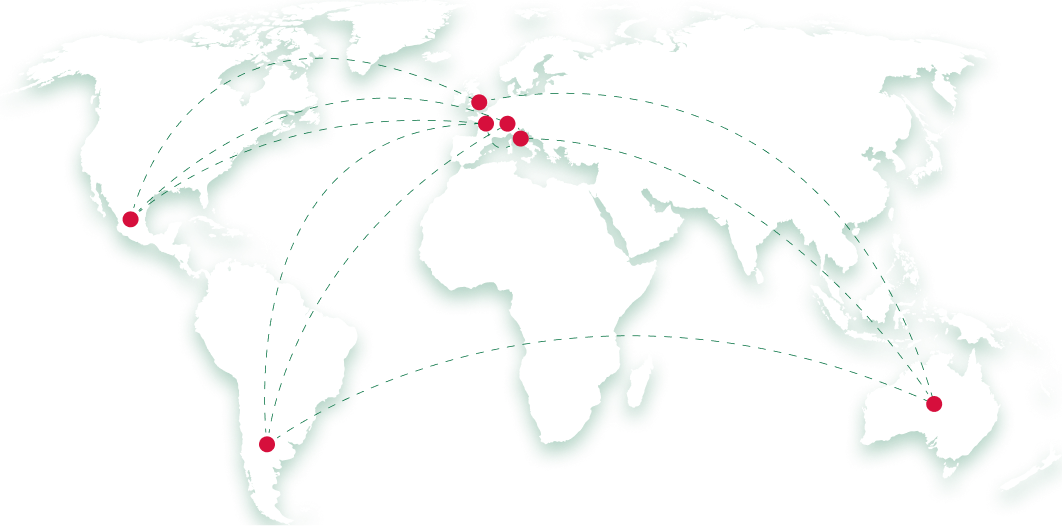
secondees
Secondment period means the period spent by the staff member in a host organisation for the purposes of the action. A secondee is a staff member hosted.
2024
Dr. Domenico Loperfido
University of Milan, Italy
CERZOS (Bahia Blanca, Argentina) from March 11, 2024 to June 8, 2024
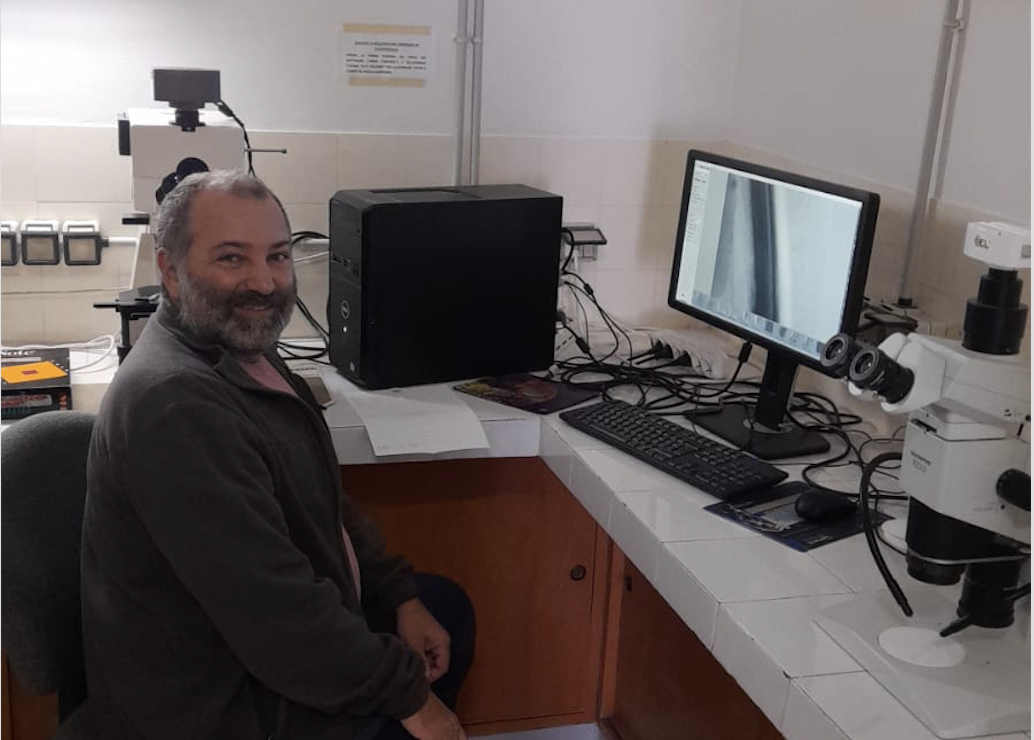
Dr. Diego Zappacosta
CERZOS, Bahia Blanca, Argentina
University of Perugia (Italy) from March 05, 2024 to April 05, 2024
The main objective of this secondment is to continue the characterization of a mapping population of Eragrostis curvula that segregates for apomixis by creating a linkage map and selecting individuals with similar molecular markers but different reproductive modes (apomictic and sexual) for future transcriptomic analysis. During these two months, in collaboration with the group of UNIPG, it is proposed to continue the analysis of the phenotypic and genetic data of a mapping population of E. curvula to generate a new consensus map and to identify molecular markers linked to apomeiosis and, ultimately, to discover genes, which may play a potential role in the control of apomictic reproduction. Additionally, I will work in a calendar to associate floral morphological parameters with megasporogenesis and megagametogenesis developmental stages in different apomictic and sexual genotypes of E. curvula (Task 3.3).
Lucia Giordano, PhD student
University of Perugia, Italy
University of Adelaide (Austalia) from January 18, 2024 to June 2, 2024
2023
Samela Draga, PhD student
University of Padova, Italy
IICAR (Rosario, Argentina) from November 3, 2023 to , January 19, 2024
Samela Draga is visiting Prof. Pessino laboratory at IICAR-CONICET-UNR from November 3, 2023, to January 18, 2024. The general objective of her work is to continue the project already started at March-July 2023, at IICAR-CONIC ET-UNR, contributing to the elucidation of the role of the splicing controller BUD13 (a TGS1 interactor) in apomictic and sexual Paspalum. BUD13 displays differential expression in florets of sexual and apomictic plants in at least two aposporous species, Paspalum notatum and Hypericum perforatum. Interestingly, Arabidopsis bud13 mutants were associated with defects in early embryo development. During her visit, she will generate digoxigenin-labeled BUD13 probe, include Paspalum ovaries in paraffin, slice the blocks, arrange the slices on glass slides and perform the ISH analysis. Observations will allow to determine spatial expression patterns of BUD13 in reproductive organs of sexual and apomictic genotypes of Paspalum notatum.
Dr. Giovanni Gabelli
University of Padova, Italy
IICAR (Rosario, Argentina) from November 15, 2023 to December 15, 2023
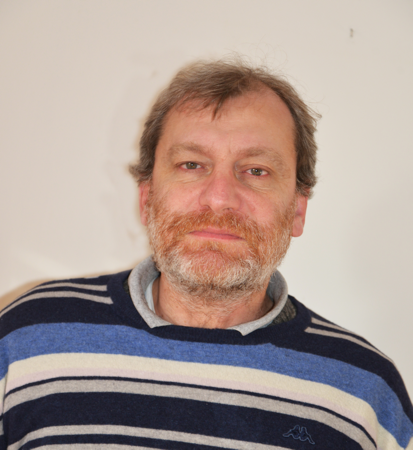
Dr. Fulvio Pupilli
IBBR, Perugia, Italy
IICAR (Rosario, Argentina) from November 8, 2023 to December 9, 2023
During this first secondment in Rosario from November 9th to December 14th 2023, Fulvio Pupilli discussed with Juan Pablo Ortiz, his staff and Olivier Leblanc the recent achievements on Nanopore sequencing and on the assembly of apomictic and sexual Paspalum simplex genomes. Furthermore he reported the insights toward the characterization of the gene PsARF5 that is differentially expressed in LCM dissected nucellus tissues of apomictic and sexual genotypes of the same species and discussed with Juan Pablo Ortiz his possible interaction with PnIAA30, a gene under characterization at IICAR. A series of in situ hybridisation experiments for this gene was scheduled for the next secondment. Finally, he prepared a talk on the role of the gene PsORC3 on maternal excess endosperm development in P.simplex and a tribute to Prof. Camilo Luis Quarin for the IV Apomixis Congress 3-7th December 2023 Rosario, Argentina.
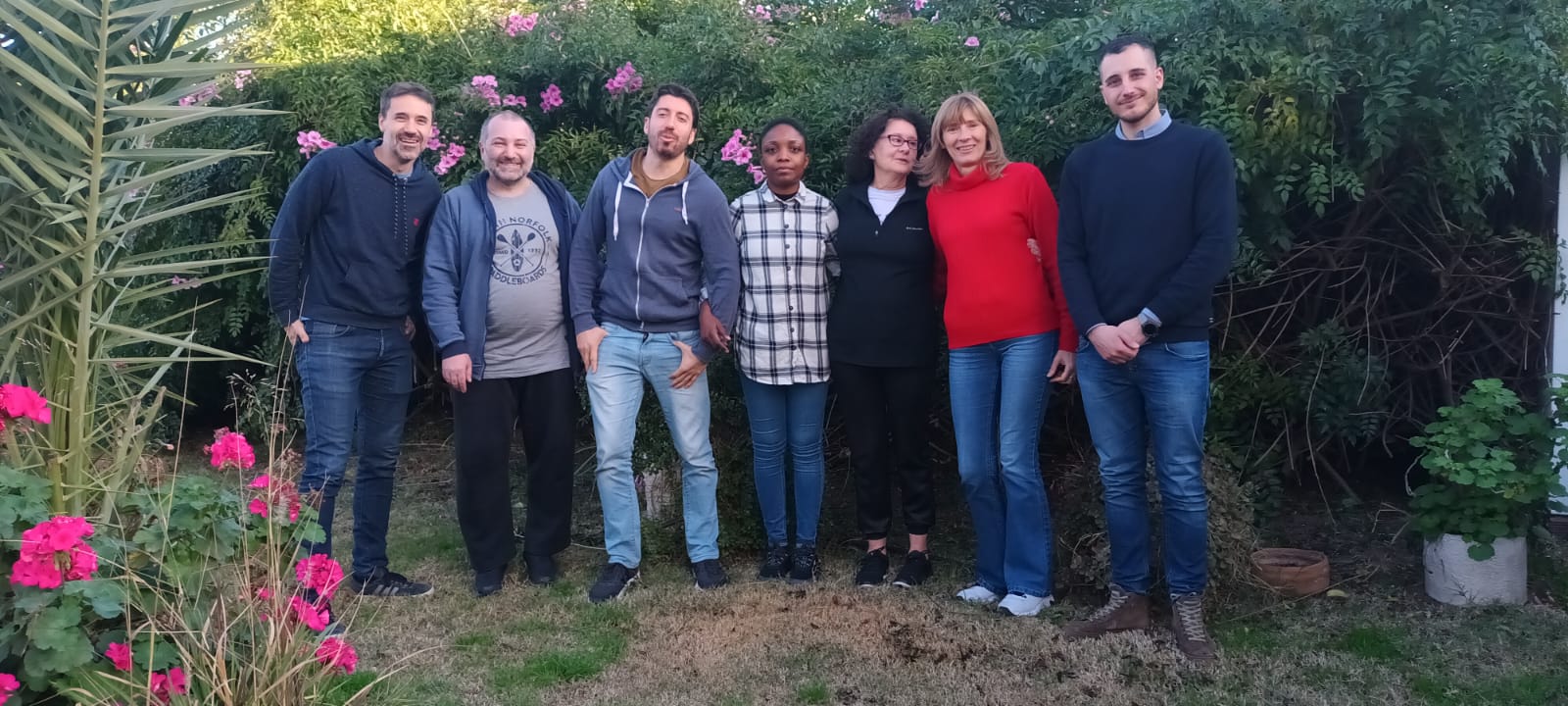
Giacomo Bongiorno, PhD student
University of Perugia, Italy
CERZOS (Bahia Blanca, Argentina) from May 18, 2023 to December 09, 2023
During this secondement at CERZOS, my primary focus was on the diplosporous grass Eragrostis curvula, aiming to construct a comprehensive pan-genome. The utilization of the diploid sexual variety, cv. Victoria, as the reference genome provided a solid foundation for investigating genomic variation, phylogenetic relationships, and the impact of ploidy on genome evolution and reproductive modes. This pan-genomic study significantly contributes to our understanding of E. curvula‘s genomic diversity, serving as a valuable resource for targeted investigations into the molecular mechanisms governing its reproductive modes and relationships with ploidy.
Picture (from left to rigth: Juan Pablo Selva, Diego Zappacosta, Juan Manuel Rodrigo, Nengi Lawson, Viviana Echenique, Alejandra Diaz & Giacomo Bongiorno

Dr. Daphné Autran
IRD, Montpellier, France
IICAR (Rosario, Argentina) from October 22, 2023 to December 17, 2023
During this secondment, we follow up the work on Paspalum rufum with Luciana Delgado. To understand the interelations between ovule primordia architecture and cell fate plasticity leading to apospory , we are performing a 3D cellular morphometric analyses of P.rufum genotypes showing differential expressivity of apospory. The first step is to build a reference 3D atlas of the sexual genotype. After the work done in previous secondments of segmentation, labelling, and data export using MorphographX (MGX) software, we set up for quantitative analysis on a pilot group of 11 ovules at successive stages covering the developmental window of interest. In addition to cell number and cell size quantification, different shape descriptors, at both cellular and organ level, were selected and calculated from features extracted by MGX. Since the pilot data already encompass thousands of cells to analyze, custom scripts in R were written to manage data compilation, visualization and statistical analysis. In addition, P.rufum ovules around meiosis stage were dissected, fixed and cleared; to extend the developmental window covered, and maximize the probability of detection of differential cell growth between sexual and aposporous genotypes.
Paspalum rufum, Luciana Delgado & Daphné Autran
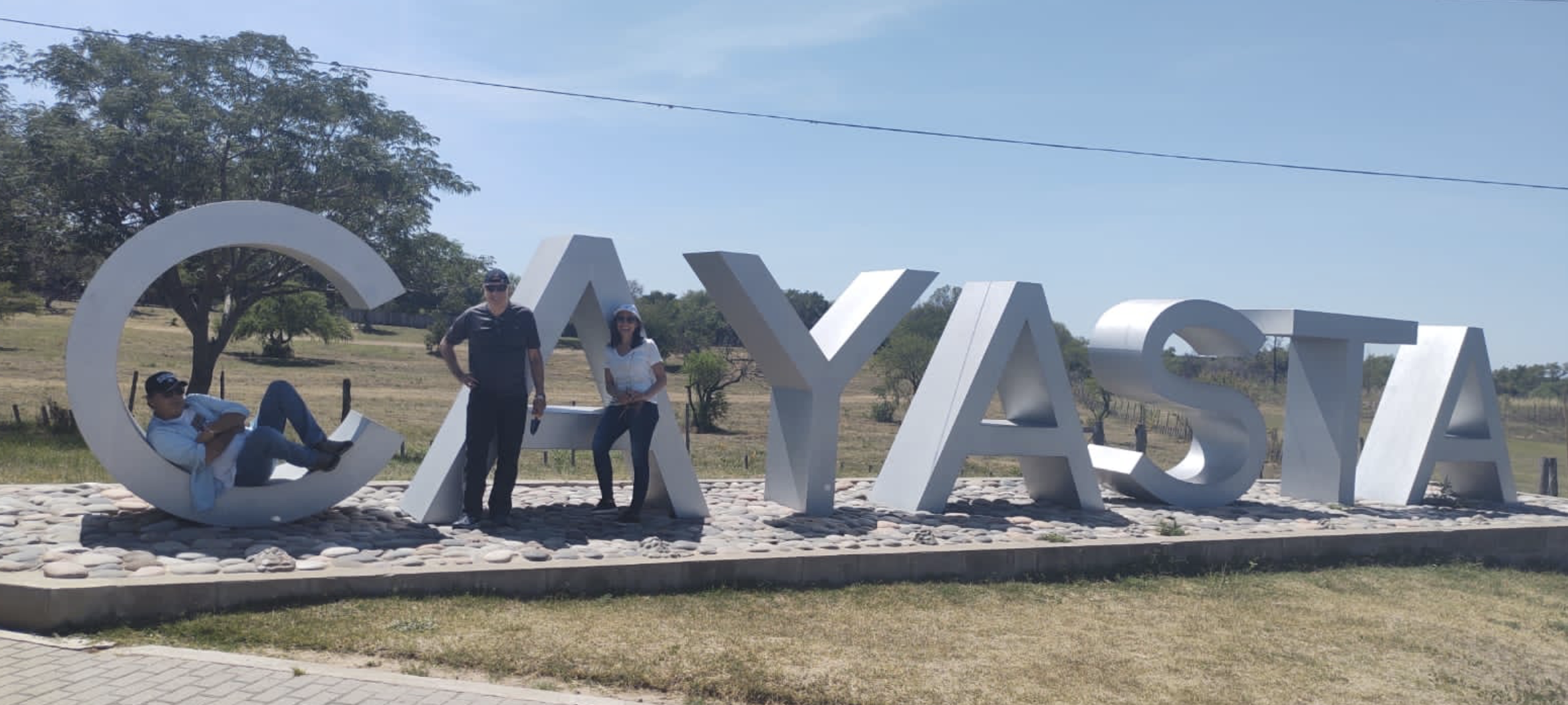
Dr. Olivier Leblanc
IRD, Montpellier, France
IICAR (Rosario, Argentina) from October 15, 2023 to December 13, 2023
This second visit to IICAR is part of a secondment dedicated to the genomics of apomixis (WP3) and the functional characterization of Paspalum candidate genes relevant for apomixis using Arabidopsis mutants (WP4). Regarding the genomic approaches, we expect to complete a first draft on the assembly and the detailed annotation of a P. notatum diploid genome reference and will focus analyses on understanding the variations between the genome of diploid, sexual plants and that of apomicts using comparative genomics and k-mer approaches. Regarding the functional characterization of Arabidopsis mutants, the effets of tgs1 mutations on RNA splicing are being analyzed using comparative transcriptional analyses and cytological tools (fluorescent reporters under construction). In addition to these activities, I’m involved in organizing the second MAD workshop on ONT sequencing and bioinformatics (Rosario, November 20-25) and the Apomixis2023 conference (Rosario, December 3-7).
Picture: visiting old friends in Cayasta (Santa Fe, Argentina), cradle of the Paspalum family. from left to right: O Leblanc, JPA Ortiz, & L Siena
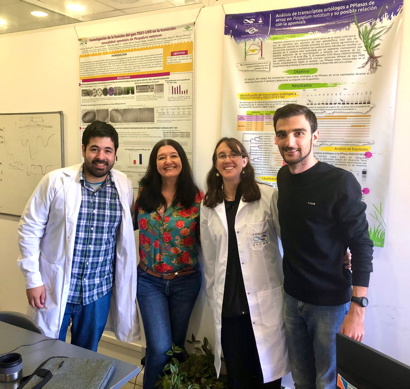
Davide Perrone
University of Milan, Italy
IICAR (Rosario, Argentina) from September 12, 2022 to December 13, 2023
Davide Perrone is visiting IICAR-CONICET in order to continue the experiments initiated during a previous secondment, concerning the transformation of apomictic and sexual Paspalum notatum plants with fluorescent auxin and cytokinin markers. The aim of these experiments is to compare the pattern of hormone distribution in the ovule between sexual and apomictic reproductive types. Moreover, in this particular secondment Davide will also start performing in-situ hybridization experiments aimed at comparing the expression of AUXIN RESPONSE FACTOR 10 (ARF10) in ovules of sexual and apomictic Paspalum notatum biotypes. Finally, in collaboration with IICAR scientists, he will perform miR-seq analyses using raw data previously generated in Milan.
Picture (from left to right): Augusto Villalba (IBONE), Silvina Pessino (IICAR), Maricel Podio (IICAR) and Davide Perrone (Univ. Milan)
Dr. Cristian Gallo
Bahia Blanca, Argentina, CERZOS
University of Perugia (Italy), from September 1st, 2023 to October 30, 2023

Dr. Francesca De Marchis
Perugia, Italia, CNR-IBBR
IICAR (Argentina), from August 11, 2023 to September 12, 2023
Francesca De Marchis is a researcher of the National Research Council, CNR- IBBR – Perugia. During her visit, she will work with Dr. Juan Pablo A. Ortiz (IICAR) and her expertise in plant biotechnology will be exploited to design a vector for Paspalum notatum transformation. Some candidates genes for triggering parthenogenesis, identified by the IICAR’s research group, will be considered for plant transformation by biolistic technology choosing for their over-expression or down-regulation.
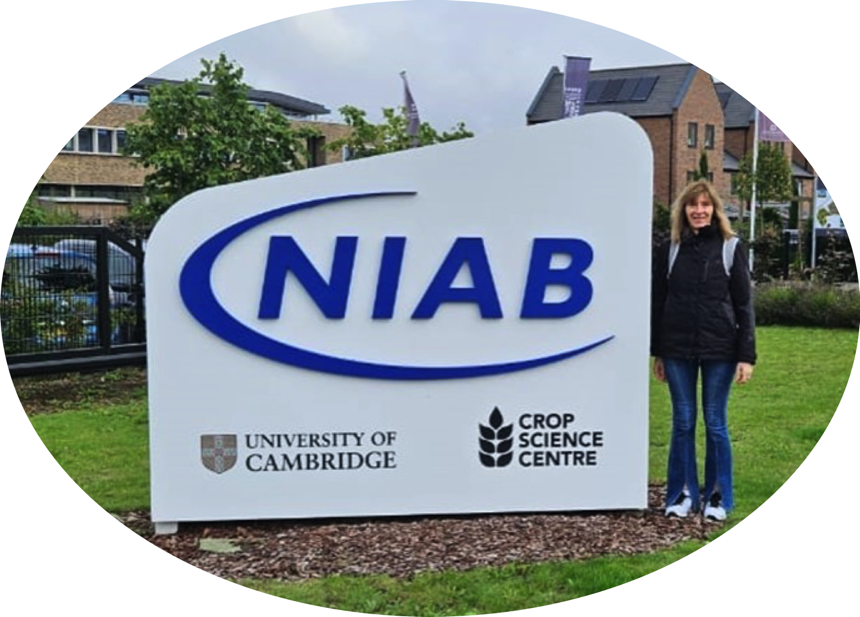
Dr. Alejandra Díaz
Bahia Blanca, Argentina, CERZOS
NIAB (UK), from August 1st, 2023 to October 2nd, 2023
For some time now, our CERZOS research group has been collaborating with Dr. Caccamo´s group at NIAB on the identification and the characterization of a genomic region involved in apomixis in Eragrostis curvula (Schrad.) Nees and its genes. Some of these, identified previously by our research group to be involved in apomictic pathways, are under functional characterization since many of them do not have an annotation in other species. Expression of these candidate under constitutive promoters in the rice plant model species is one of the approaches used for their characterization. The aim of this secondment at NIAB was to advance the characterization of one of our candidate genes, mainly to determine whether its overexpression led to any defect in embryo sac development. To achieve this, I was involved in the screening of reproductive tissues from spikelets of independent transgenic rice lines generated at NIAB and overexpressing the gene of interest (WP4). We used Differential Interference Contrast (DIC) microscopy to observe reproductive tissues cleared with a methyl salicylate solution, as this technique enables large-scale observations on meiosis and embryo sac development in intact ovules. Thus, the collaboration between NIAB and CERZOS will allow us to get faster characterization of the candiate genes for apomixis identified in Eragrostis.

Dr. Viviana Echenique
Bahia Blanca, Argentina, CERZOS
NIAB (UK), from August 1st, 2023 to October 2nd, 2023
The objective of my secondment at NIAB was to continue with the work started with Dr. Caccamo´s group aiming at the identification and the characterization of a genomic region and genes involved in apomixis. Here we discussed strategies and designed new experiments. The ongoing work consists on the sequencing and the assembly of the genome of the apomictic cultivar Don Walter (Eragrostis curvula). This genome was sequenced at NIAB using the Oxford nanopore platform with the super-high accuracy plant model protocol and one of the students from CERZOS is working here doing the assembly. We also are involved in a transcriptomics project using RNA-seq data obtained from pistil tissues of apomictic and sexual plants in three different developmental stages. We are looking for differentially expressed genes between plants with different reproductive modes and different developmental stages.
Picture: Viviana at The Eagle, Cambridge (UK)
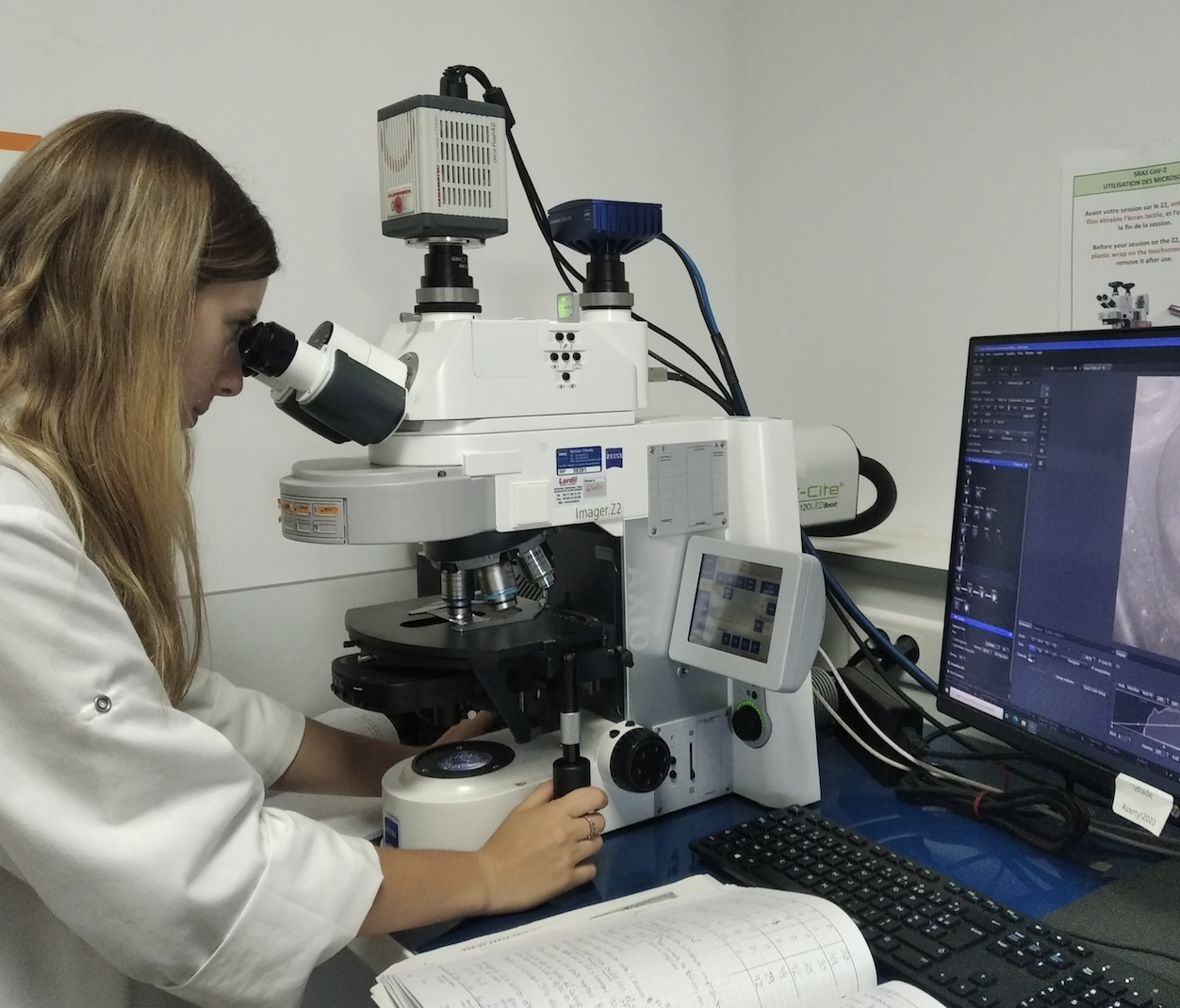
Sol Vega, PhD student
Rosario, Argentina, IICAR
IRD (France), from July 20, 2022 to September 20, 2022
In this secondment María Sol is visiting IRD to continue with the functional characterization of the IAA16 gene in Arabidopsis thaliana, whose orthologue (IAA30) has been associated with apomixis in Paspalum notatum. The activities will be carried out in the laboratory of Dr. Olivier Leblanc and will include the recovery of double homozygous plants derived from crosses between the iaa16 mutant and; a line carrying the pWOX2-CENH3-GFP gametophytic reporter; tgs1 plants (related to alterations in gametophyte development), and; topless plants (involved in the auxin response during embryogenesis). Phenotypic analyses of the reproductive development of the materials obtained will be carried out using fluorescence or DIC microscopy during the secondment and at IICAR. In addition, the study of mutants for other genes from the IAA16 clade (iaa14 and iaa17) as well as for a new IAA16 insertion will be initiated.

Dr. Lorena Siena
Rosario, Argentina, IICAR
IRD (France), from June 22, 2023 to September 16, 2023
In this secondment, Lorena Siena from IICAR, is visiting IRD for three months. The objective of the visit is to advance the functional characterization of the TGS1 and QGJ genes during Arabidopsis thaliana reproductive development. The activities will be carried out in collaboration with the IRD group and, first, include the exploring of the potential for parthenogenetic embryos in tgs1 mutant lines by using embryo-specific fluorescent reporters transmitted maternally and paternally. In addition, the cellular identity of the extra, functional megaspores observed in qgj ovules will be extensively characterized, e.g. using the pWOX2-CENH3-GFP reporter. Moreover, we will initiate experiments aiming at identifying potential interactions between QGJ and TGS1 by determining QGJ expression pattern (pQGJ-GUS) in tgs1 ovules and, reciprocally, that of TGS1 (pTGS1:TGS1-GUS) in qgj ovules.
Picture: Montpellier aqueduct (@ Lorena Siena, IICAR).
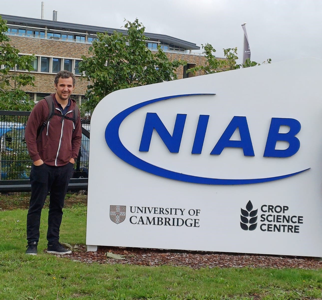
Dr. Jose Carballo
Bahia Blanca, Argentina, CERZOS
NIAB (UK), from June 14, 2023 to September 14, 2023
The objective of my secondment at NIAB was to continue with the sequencing and assembly of the apomictic genome of Eragrostis curvula. The genome of Don Walter genotype was sequenced at NIAB institute using the Oxford nanopore platform with the super-high accuracy plant model protocol. These reads were assembled using Flye software and scaffolded with Omni-C technology in order to obtain a chromosome scale assembly. This genome was assembled and annotated obtaining the A and B sub-genomes of the allotetraploid Don Walter. Moreover, during this time in Cambridge, the RNA-seq data obtained from pistil tissues of apomictic and sexual plants in three different developmental stages was analysed obtaining differentially expressed genes. This secondment continues with the collaborative efforts between NIAB and CERZOS-CONICET in order to disclose the molecular basis of apomixis through a bioinformatic approach.
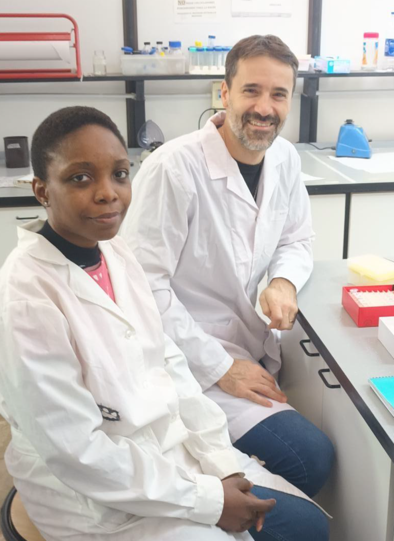
Dr. Tamunonengiye-ofori Lawson
Cambridge, UK, NIAB
CERZOS (Argentina), from May 20, 2023 to July 19, 2023
The objective of this secondment at CERZOS was to gain deeper knowledge, skills and practical experiencein teh area of in-situ hybridization and DIC microscopy in plants.
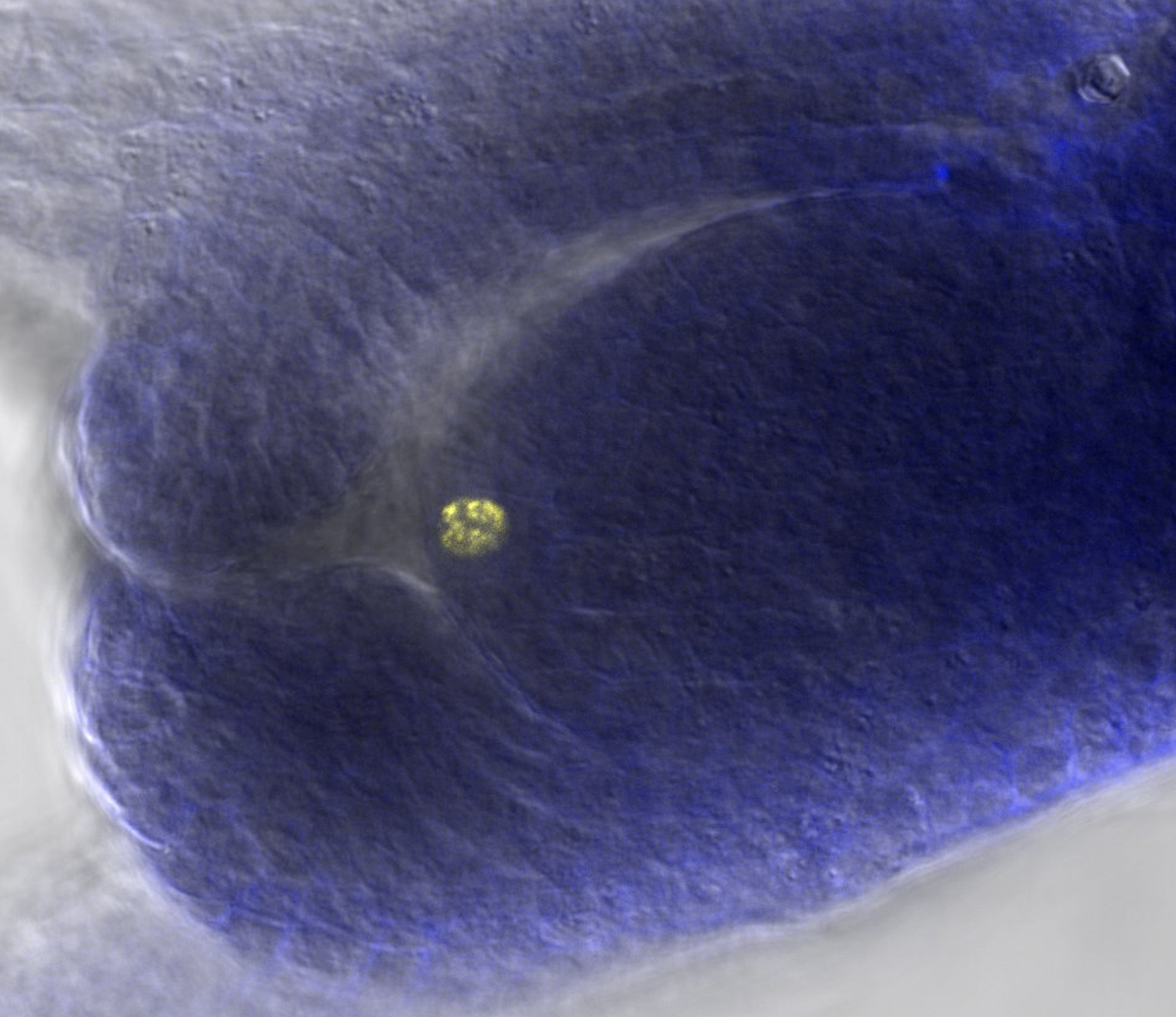
Dr. Luciana Delgado
Rosario, Argentina, IICAR
IRD (France), from May 20, 2023 to August 19, 2023
This secondment continues the tasks initiated in 2022 with Dr. Daphné Autran to build a 3D atlas of early ovule development in Paspalum rufum. We will segment and classify the cells within ovules primordia using high resolution images obtained previously, and a previously established and partially automated workflow using the open source software MorphoGraphX. In parallel, we will test different staining protocols to allow incorporation and detection of a thymidine analogue (EdU) for quantifying location and duration of cell divisions during ovule development in different grasses, including two sexual model species (rice and maize) and Paspalum apomicts. This protocol was successfully used in Arabidopsis and a few other species, it will be useful optimizing conditions for grass species showing disparities in flower and ovule morphologies. Quantitative information from the 3D Atlas and cell division in sexual and apomictic genotypes should help us understand the switch between the two reproductive pathways.
Picture: Interphase cell in a young ovule of Paspalum rufum showing fluorescent signal from DNA containing EdU (@ Luciana Delgado, IICAR).
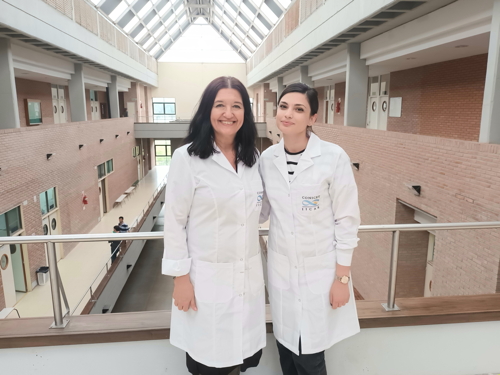
Samela Draga, PhD student
University of Padova, Italy
IICAR (Rosario, Argentina) from May 16, 2023 to Aug. 2, 2023
The general objective of Samela’s work at IICAR is to contribute to the elucidation of the role of the splicing protein BUD13 in the apomixis-sexuality switch. During her stay she will analyze the representation of BUD13 in transcriptomic and genomic databases of Paspalum notatum and generate suitable RNA hybridization probes. Moreover, she will classify ovules of sexual and apomictic Paspalum notatum plants according to developmental stages by using DIC cytoembryology, dehydrate them in an ethanol/xylol series and include them in paraffin. In a second visit (from October to December) she will prepare ovule sections for hybridization using sense and antisense digoxigenine-labelled RNA probes detected by colorimetric reaction using an anti-DIG conjugated with alkaline phosphase and NBT/BCIP substrates. We expect to produce information on the spatial differential expression of these candidate genes in apomictic and sexual genotypes.
Samela Draga (right) & Silvina Pessino (left)
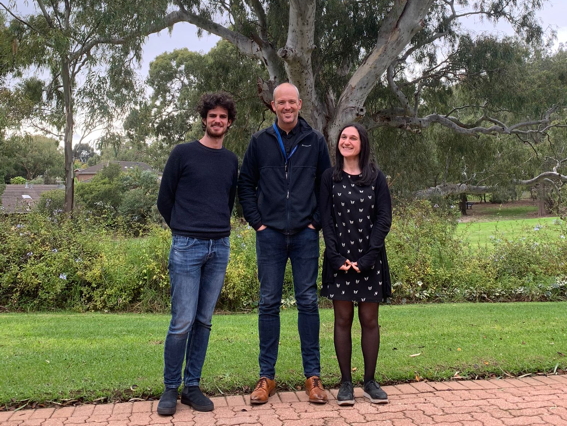
Nicola Babolin, PhD student
University of Milan, Italy
University of Adelaide (Australia) from April 10, 2023 to October 13, 2023
During my secondment in the University of Adelaide (Australia) in A/Prof. Matthew Tucker laboratory I’m willing to better characterize the molecular network between the two MADS-box genes STK and ABS during the fertilization process and seed development in Arabidopsis thaliana.
At the same time I will be involved on the projects run by Prof. Tucker team on barley plant concerning ovule and seed development highly interconnected with my project in Arabidopsis.
From left to right: Nicola Babolin, Mathew Tucker, Rosanna Petrella
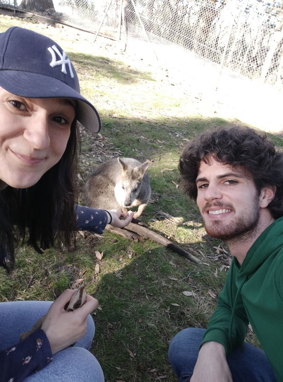
Dr. Rosanna Petrella
University of Milan, Italy
University of Adelaide (Australia) from April 10, 2023 to October 13, 2023
During my secondment at The University of Adelaide (Matthew Tucker’s lab) my work will be focused on unravelling the molecular mechanisms determining a correct female germline progression in Arabidopsis thaliana. In particular, I will try to characterize the main players involved in spore degeneration and functional megaspore selection and differentiation at the end of megasporogenesis in the ovule. I will determine the contribution of phytohormone cross-talk by trying to rescue mutants defective in this key processes using specific regulatory regions active in different domain of the ovule to specifically drive the expression of candidate genes.
From left to right: Rosanna Petrella, Skippy the Kangaroo, Nicola Babolin

Mattia Spano, PhD student
University of Milan, Italy
LANGEBIO (Mexico) from April 1, 2023 to July 20, 2023
The aim of this secondment is to investigate molecular mechanism determining female germline. In particular, I will investigate the contributions of phytohormones, auxin and cytokinines, in MMC differentiation. The species investigated are Arabidopsis thaliana and Oryza sativa var. Kitaake. In this frame, I will perform Immunolocalization assays in different backgrounds to localize phytohormones during ovule development using spl/nzz mutant and wild type Arabidopsis and wild type for Oryza sativa.
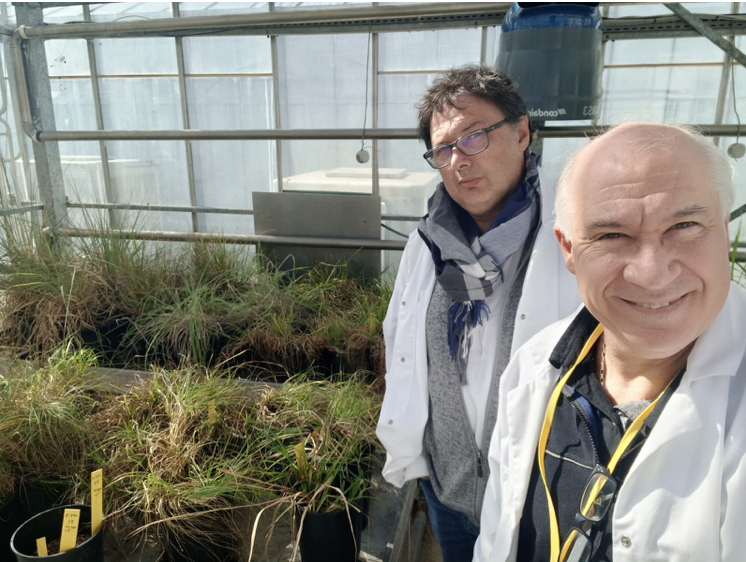
Dr. Juan Pablo A. Ortiz
Rosario, Argentina, IICAR
IRD (France), from March 7, 2023 to April 3rd, 2023
A new stay at IRD of Dr. Juan Pablo A. Ortiz from IICAR, carried out as part of a MAD secondment for the characterization of apomictic genomes (WP3), started March 7, 2023. The work plan includes DNA extraction of several samples of Paspalum spp, intended for Illumina sequencing and further genome structural analyses. The visit is also dedicated to preparing a new manuscript describing the sequencing, chromosome-level assembly and annotation of a Paspalum notatum diploid genome. This achievement is a key step for WP3 progression because it will serve as a reference for characterizing tetraploid genomes and determining the structure and evolution of the apomixis region. This manuscript is the result of a collaborative effort between MAD partners from Argentina, Italy, and France. Finally, the program of the international workshop on Nanopore sequencing and bioinformatics, organized by the MAD project in Rosario, Argentina next November will be discussed and decided during this visit.
IRD plant greenhouse. Juan Pablo A. Ortiz (right) & Olivier Leblanc (left)
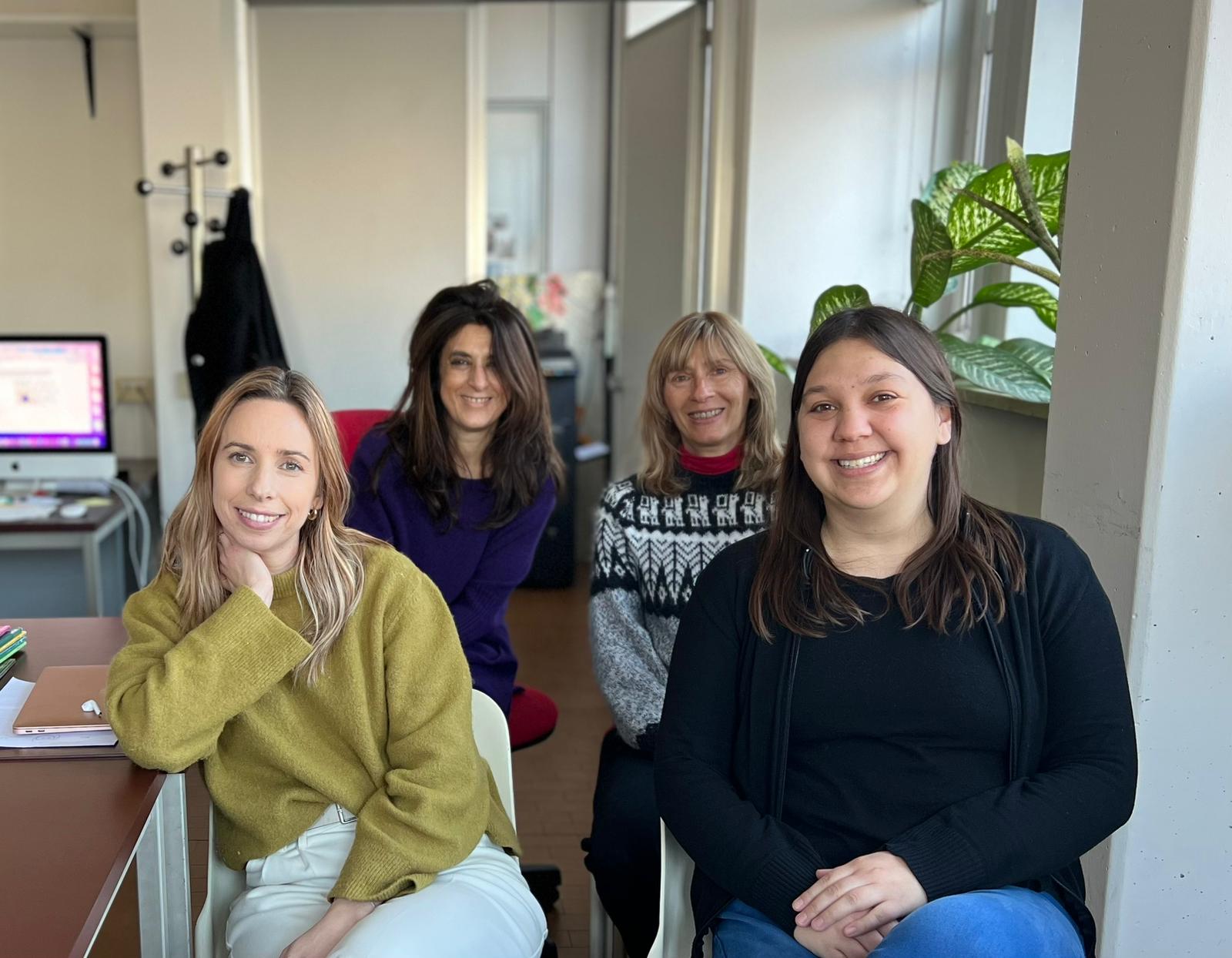
Dr. Alejandra Díaz
Bahia Blanca, Argentina, CERZOS
University of Milan (Italy) from Jan 21, 2023 to March 23, 2023
The aim of this secondment was to analyze the tissue-specific expression of two candidate genes involved in the apomictic reproductive mode in the grass Eragrostis curvula (WP4). For this purpose, we used RNA in situ hybridization technic (RNA-ISH) to determine the expression patterns cell-specific of these two genes in the reproductive organs of E. curvula, both in the full apomictic and sexual genotypes. In addition, we also characterized a gene that shows differential expression between sexual and apomictic E. curvula plants and that is also expressed in the model plant A. thaliana. For the latter objective, we also used ISH to test the RNA abundance and localization of this orthologous gene in the reproductive tissues of E. curvula (apomictic and sexual genotypes) and A. thaliana (diploid and tetraploid genotypes).
From left to right: Mareta Mendes, Lucia Colombo, Alejandra Díaz and Cielo Pasten
2022
Gregorio Orozco
University of Milan, Italy
LANGEBIO (Mexico) from Dec. 7, 2022 to Feb. 3, 2023
Dr. Lucia Colombo
University of Milan, Italy
IICAR (Rosario, Argentina) from Nov. 14, 2022 to Nov. 27, 2022
Jimena Gallardo
Bahia Blanca, Argentina, CERZOS
University of Perugia (Italy), from Nov. 2, 2022 to Dec 2, 2022

Dr. Olivier Leblanc
Montpellier, France, IRD
IICAR (Argentina) from Oct. 17, 2022 to Dec. 16, 2022
This secondment aims at pursuing (1) the characterization of the chromosomic region associated with apomixis in tropical forages. As we now have completed the assembly and the annotation of the genome of a diploid, sexual individual, different approaches will be explored to reveal structural genomic variations that underlie the apomictic development in Paspalum species. To achieve this, we produced > 100 Gb of long reads (Nanopore technology) from several Paspalum apomictic races that will be used for de novo assembly and comparative analyses, and; (2) the functional analysis of tgs1 Arabidopsis mutants and, more particularly, the comparative transcriptional analysis in tgs1 and WT Arabidopsis embryos collected at early developmental stages. These activities are part of WP3 and WP4, respectively.
Picture: Metallic clones in the pampa outside of Rosario, Province of Santa Fe, Argentina (@ O Leblanc)

Dra. Maria Cielo Pasten
Bahia Blanca, Argentina, CERZOS
University of Milan (Italy) from Sept. 30, 2022 to March 1, 2023
The objective of this detachment was to analyze genes that show differential expression between sexual and apomictic ovules of Eragrostis curvula plants and, which are also present in the model plant Arabidopsis thaliana. For this purpose, we studied the phenotype of A. thaliana mutants publicly available for some of these genes but, also, that of new transgenic mutant lines generated by the CRISPR-Cas9 strategy. In addition, ovule development in apomictic and sexual genotypes of E. curvula was characterized using confocal microscopy to further our knowledge on the structures and differences between sexual and asexual modes of reproduction.
From left to right: Marta Mendes, Lucia Colombo, Alejandra Díaz and Cielo Pasten
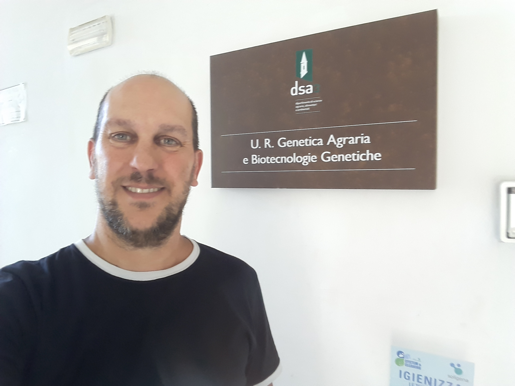
Pr. Pablo Roncallo
Bahia Blanca, Argentina, CERZOS
University of Perugia (Italy) from Sept. 6, 2022 to Nov. 8, 2022
The objective of this secondment is to extend a tetraploid genetic linkage map of Eragrostis curvula using DarT seq markers and additional F1 genotypes in order to map more precisely the region involved in apomixis. The F1 population was obtained by crossing a sexual (OTA) and an apomictic genotypes (Don Walter) as maternal and paternal parents, respectively. This new linkage map will facilitate the localization of loci controlling apomixis (diplospory) and to study the genome evolution in this grass (WP3). In collaboration with the UNIPG group, I am analyzing molecular markers (DarT seq) obtained in new F1 individuals and in others previously obtained in Bahía Blanca by our group to construct a new integrated linkage map, as well as two parent-specific linkage maps. For this, segregation analysis and detection of polymorphic SNP markers in one or both parent is needed to solve this three linkage maps. Additionally, the haplotype reconstruction using this F1 population will be explores and parental SNP profile.
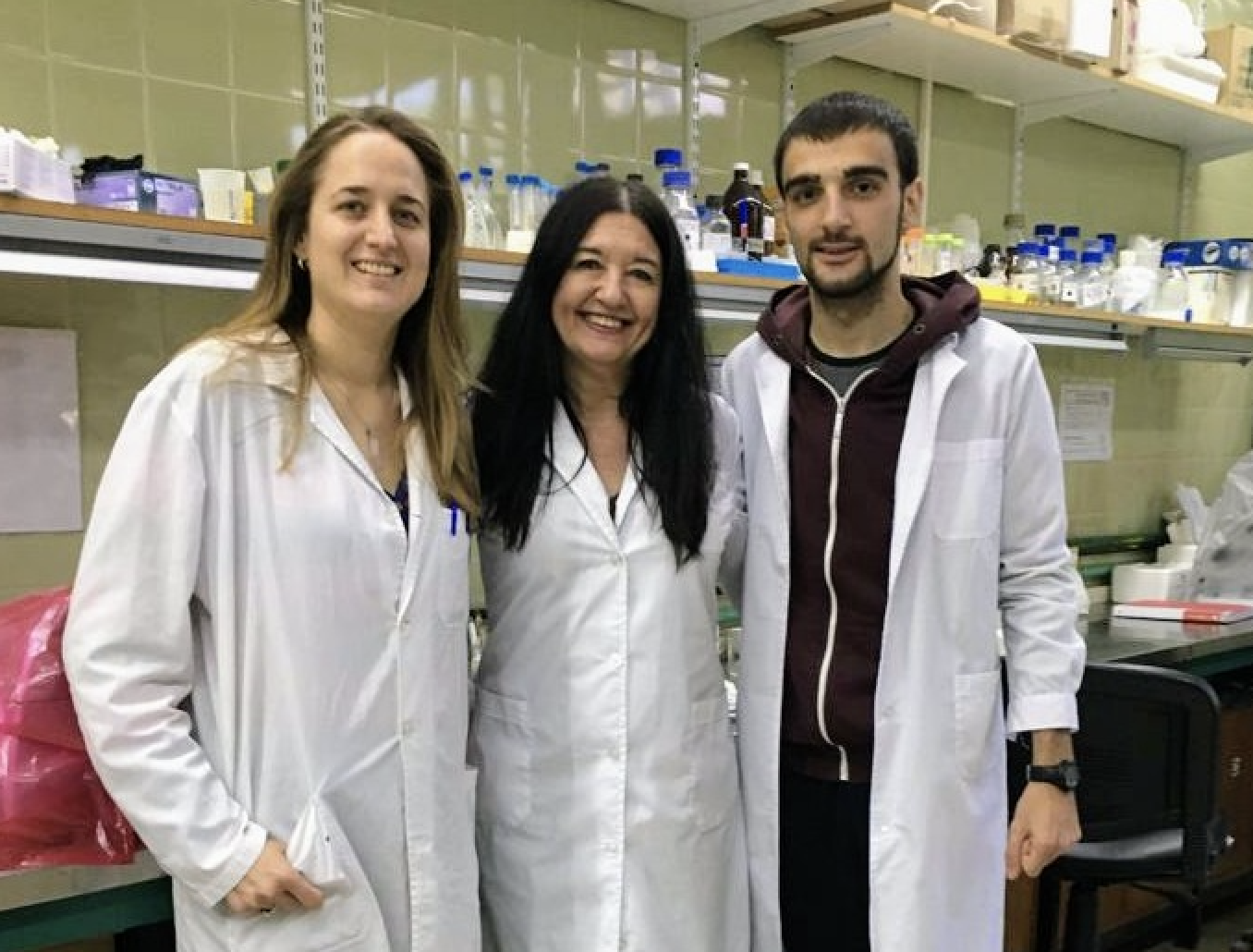
Davide Perrone
University of Milan, Italy
IICAR (Rosario, Argentina) from Sept. 2, 2022 to Nov. 28, 2022
Davide Perrone (University of Milan, Italy) is visiting Prof. Silvina Pessino laboratory at IICAR CONICET, Rosario, Argentina, from 3rd September to 27th November 2022. His work, conducted in collaboration with Dr. Carolina Colono (IICAR-CONICET-UNR), is aimed at using biolistic transformation to produce DR5 (auxin marker) and TCS (cytokinin marker) Paspalum notatum fluorescent lines with different reproductive modes (sexuality and aposporous apomixis). These plant materials will be useful to study the ovular hormone patterns along different developmental stages in a well-characterized apomictic model. Moreover, Davide is contributing to study the role of AUXIN RESPONSE FACTOR 10 (ARF10) in the transport of auxin within the Arabidopsis ovule, by doing cytoembryological characterizations of arf10 x PIN1 and arf10 x DII-Venus crosses previously obtained at IICAR-CONICET-UNR. Finally, he is involved in the analysis of the functional connexion between AUXIN RESPONSE FACTOR 10 (ARF10) and TRIMETHYL GUANOSINE SYNTHASE (TGS1) (a reported apospory controller) in Paspalum.
From left to rigth: Carolina Colono, Silvina Pessino and Davide Perrone
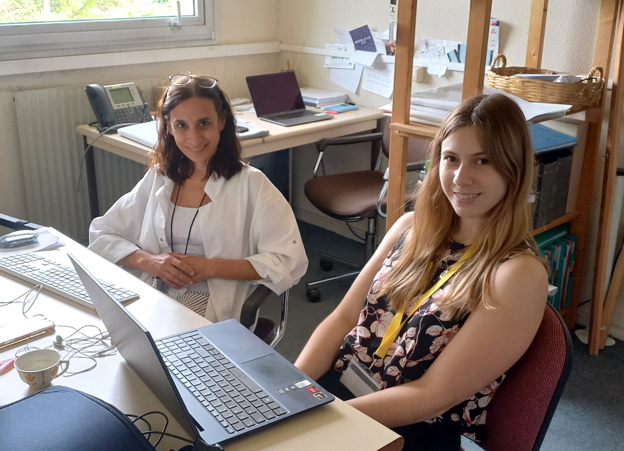
Sol Vega, PhD student
Rosario, Argentina, IICAR
IRD (France), from June 15, 2022 to August 16, 2022
Maria Sol is a PhD fellow at IICAR-CONICET, Argentina, and she is visiting the laboratory of Dr. Olivier Leblanc at IRD (Montpellier, France). The main objective of her stay is to initiate the functional analysis of Arabidopsis mutants defective for the IAA16 gene, whose orthologue in Paspalum notatum (PsIAA30) is down-regulated during apomictic development (Siena et al., Plants 2022, 11, 472). Heterozygous and homozygous iaa16 mutants will be analyzed by cytoembryological observations to search for possible female reproductive phenotypes reminiscent of aposporous apomixis. These activities will then contribute to determine the effects of IAA16 depletion on the reproductive development of Arabidopsis and to plan further functional characterization for this or other genes that belong to the pathway. During her visit, Maria Sol will work in collaboration with Dr. Olivier Leblanc and Caroline Michaud from IRD, and with Lorena Siena, her PhD supervisor at IICAR.
Lorena Siena (left) & Sol Vega (right)

Dr. Juan Pablo A. Ortiz
Rosario, Argentina, IICAR
IRD (France), from June 7, 2022 to July 7, 2022
A new MAD secondment to work on the characterization of apomictic genomes (WP3) started on June 7, 2022. On this occasion, Dr. Juan Pablo A. Ortiz from IICAR (CONICET-UNR, Argentina) is visiting the laboratory of Dr. Olivier Leblanc at IRD (France). The workplan includes the annotation of a genome assembly of a diploid Pensacola bahiagrass ecotype (Paspalum notatum, var. saurae Parodi), obtained previously in a collaboration between laboratories of France, Italy, and Argentina. We also intend to identify and to characterize sequences related to the apomixis controlling locus (ACL) in a tetraploid race. In particular, we will use the ONT “adaptive sampling” technology that allows sequencing of regions of interest. Therefore, we expect to enrich our sequencing with reads specific from the tetraploid apomictic plant and then assemble the ACL. Olivier Leblanc, Cédric Mariac and Julie Orjuela (DIADE research Unit), as well as Juan Manuel Vega (MAD seconded from IICAR) will contribute to this work.
Juan Pablo Ortiz (left) & Olivier Leblanc (right)
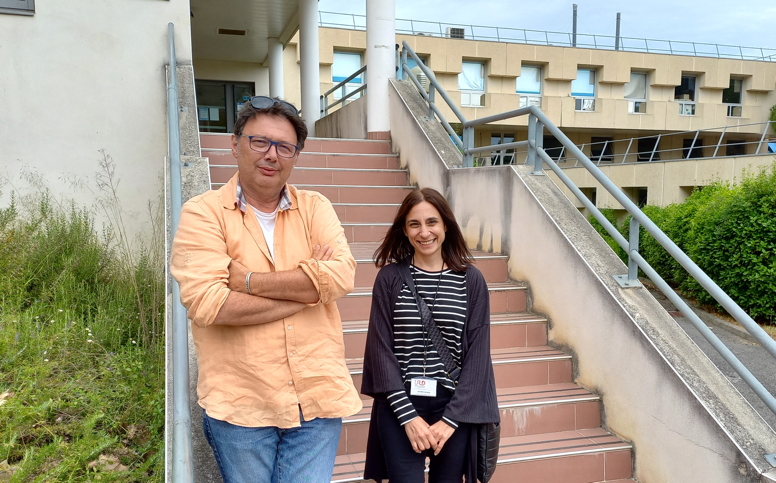
Dra. Lorena Siena
Rosario, Argentina, IICAR
IRD (France), from June 6, 2022 to September 1st, 2022
During this 3-month secondment, Lorena Siena (IICAR, CONICET- Argentina) is visiting IRD with the objective of advancing the functional characterization of the TGS1 gene during the reproductive development of the model plant Arabidopsis thaliana. The activities will be carried out in collaboration with Dr. Olivier Leblanc and his IRD group, and include: complementation tests using the pTGS1:TGS1-GUS construct; determining the origin of the extra embryo sacs observed in tgs1 mutants using reporter lines carrying the pWOX2 and CENH3 genes reporting both female gametophytic identity and chromosome number (reduced vs. unreduced origin) , and; analysis of RNAseq data obtained from wild type and tgs1 embryos at early stages of embryonic development. This study aims to determine the alterations in gene expression patterns caused by TGS1 depletion; to identify their potential target genes, and; to explore whether alternative splicing controls early embryogenesis in plants.
Olivier Leblanc (left) & Lorena Siena (right)
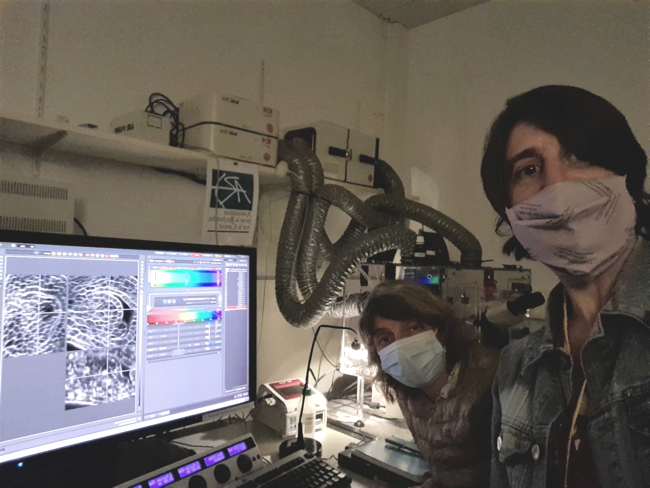
Dra. Luciana Delgado
Rosario, Argentina, IICAR
IBBR (Italy), from May 5, 2022 to June 6, 2022
In this secondment, Dr Luciana Delgado (IICAR) and Dr Daphné Autran work together to study the communication between cell division, expansion and differentiation throughout female reproductive development in P. rufum, an apomictic species. The overall aim is to build a 3D atlas of early ovule development. During the stay we will establish the optimal conditions for clarification of P. rufum ovules and cell wall staining techniques to obtain high-resolution 3D images. The images will be segmented with MorphoGraphX, classified by developmental stage, and finally a quantitative analysis of cellular descriptors will be performed. We believe that understanding the coordination between reproductive developmental processes with cell growth and division, in an apomictic context could be enlightening for understanding the regulation of apomixis.
Daphné Autran (left) & Luciana Delgado (right)
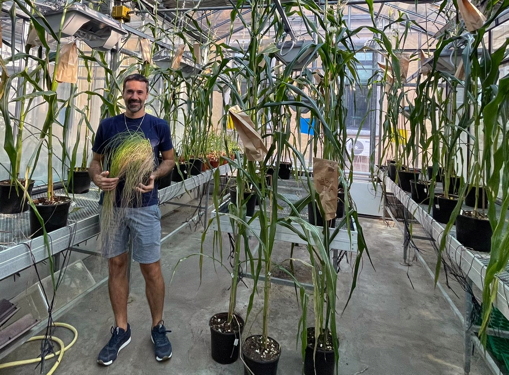
Dr. Juan Pablo Selva
Bahia Blanca, Argentina, CERZOS
University of Milan (Italy), from May 16, 2022 to July 16, 2022
The objective of this secondment was to continue with the functional characterization of a gene differentially expressed in sexual and apomictic plants of Eragrostis curvula using maize mutants carrying a Mutator insertion in the orthologous gene.
During these two months, I collaborated with the group of Professor Gabriella Consonni to evaluate different maize F2 populations that were planted in an experimental field. Plants were genotyped using specific primers for the transposon insertion located in the first exon of the orthologous gene and specific primers for the wild type allele. Activities also included observations of cleared pistils under the microscope searching for abnormalities during female reproductive development.
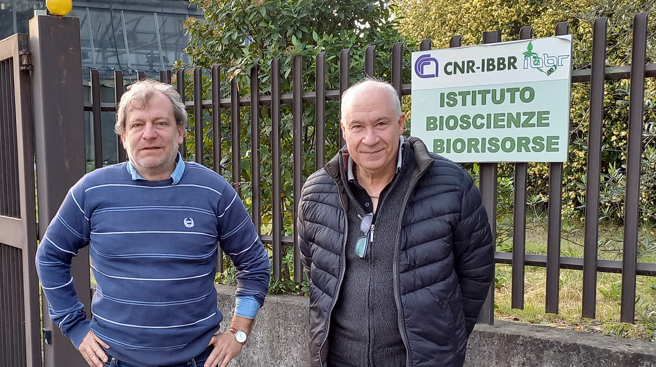
Dr. Juan Pablo A. Ortiz
Rosario, Argentina, IICAR
IBBR, from May 5, 2022 to June 6, 2022
A new MAD secondment involving researchers from Argentina and Italy started May 9, 2022 for one month! Indeed, Dr. Juan Pablo A. Ortiz from IICAR, (CONICET-UNR) is visiting Dr. Fulvio Pupilli’s lab at the Institute of Biosciences and Bioresources (IBBR-CNR) of Perugia. The working plan is focused on the functional analysis of ORC3, a gene that segregates as completely linked to apomixis, in the formation of the endosperm of Paspalum simplex apomicts. Moreover, it is also intented to progress in the assembly and the characterization of the P. simplex genome using long reads generated using the Oxford Nanopore sequencing technology. Dr. Pupilli group’s members involved in these projects are: Dra. María Eugenia Cáceres, Dr. Andrea Rubini, Dra. Francesca De Marchis and Dr. Michele Bellucci. By the end of the secondment, we expect to have completed the redaction of a manuscript on PsORC3 functional analysis and produced a draft assembly of the P. simplex genome.
Fulvio Pupilli (left) & Juan Pablo A. Ortiz (right)

Dr. Carolina Colono & Prof. Silvina Pessino
Rosario, Argentina, IICAR
University of Milan, from April 29, 2022 to July 2nd, 2022
From April 29 to July 2nd, 2022 Dr. Carolina Colono and Prof. Silvina Pessino will be visiting Prof. Lucia Colombo laboratory at the University of Milan, to explore the role of the hormonal control in the transition from sexuality to apomixis using the model plant Arabidopsis thaliana.
From left to rigth: Carolina Colono, SIlvina Pessino and Lucia Colombo

Juan Manuel Vega, PhD student
Rosario, Argentina, IICAR
IRD, Montpellier (France), from April 19, 2022 to June 18, 2022
This secondment is part of the effort undertaken by the MAD project (see WP3 objectives) to determine the nature, the evolution and the functional role of the apospory controlling region (ACR) in Paspalum notatum. By taking advantage of a diploid reference genome and long reads data sets available for tetraploid apomicts, I will first use the adaptive sampling method offered by the ONT sequencing platform to enrich sequencing of ACR long reads and then perform a high coverage assembly for both an obligate apomict and a facultative apomict. Complementary approaches by using open source methods aiming at identifying and filtering structural variations will also be applied. Altogether, this should allow structural and comparative genomics to determine the genetic content and coding/regulatory capacity within the ACR and provide cues for its functional role in the emergence of apomixis in Paspalum.
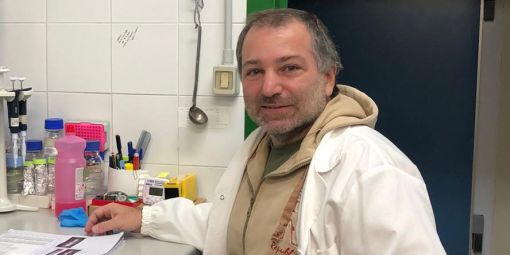
Dr. Diego Zappacosta
Bahia Blanca, Argentina, CERZOS
University of Perugia (Italy), from March 1st, 2022 to May 7, 2022
The objective of this secondment is to continue the assembly of Eragrostis curvula tetraploid genomes to determine the locus controlling apomixis and study genome evolution in this grass (WP 3). During these two months, I will analyze, in collaboration with the group of UNIPG, the genetic relationships between the sexual diploid (cv Victoria), previously sequenced and published by the 2 institutions, and the apomictic tetraploid cv. Tanganyika. We will first assemble a pan-genome and resolve it into the core genome and the dispensable genome. The reads mapping onto the Victoria reference will be assembled while unmapped reads will be assembled de novo to analyze the presence/absence variations. We will next analyze orthologous genes to find contractions and expansions of gene families and compare regions controlling apomixis in Eragrostis and Paspalum spp. Finally, I will apply the MCSeEd protocol developed by UNIPG to compare differentially methylated regions between apomictic and sexual genotypes (Task 3.3).
